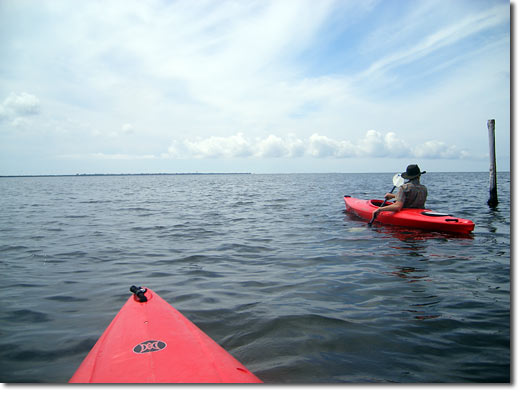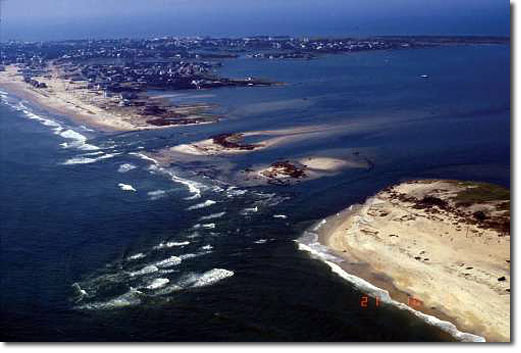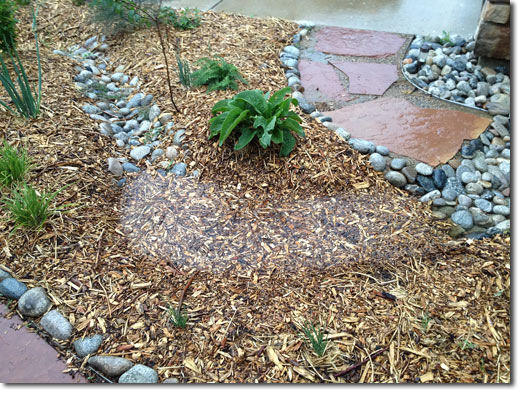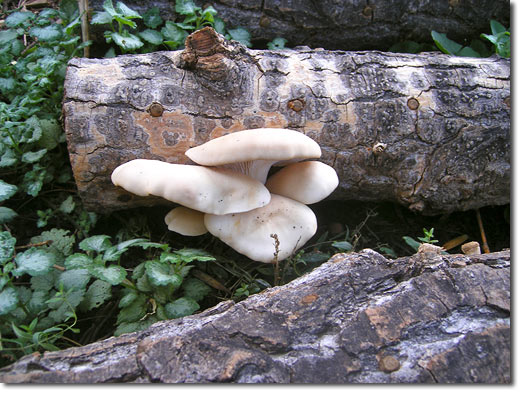Published: 8/29/2012
Being a resident of the dryland Western US, I should probably be thinking more about wildfire and drought than storm surge and coastal erosion, but for some reason, I’ve been drawn to the shoreline recently. As I have yet to come across any significant permaculture analysis or design strategy for barrier islands and associated coasts, most of this discussion is drawn from applying permaculture design thinking to other research. My hope is that this article will inspire others to develop and contribute more specific permaculture content for such important ecosystems and communities.
As large hurricanes continually batter the Eastern coast of the United States, causing catastrophic damage and human suffering, it is time to think about how permaculture design applies to human communities in such environments. From 100-year floods to wildland fire to coastal superstorms, modern infrastructure is proving to be insufficiently designed to deal with such destructive forces of nature. As permaculture designers, we attempt to work with nature, harmonizing what we design with natural forces, while using those forces as a resource, patterning after them, pacifying them, or deflecting them.
The inherent nature of barrier islands and associated coastline is one of rapid and constant change, literally a foundation of shifting sands. Constant disturbance is perhaps the antithesis of permaculture (PERMANENT-culture), so the question must be asked — how does permaculture apply in a place like this? Do we attempt to create greater stability or do we work with the changing nature of the place? Or do we suggest that people shouldn’t be living in such places at all?
Ecosystem edges
On the Atlantic coast of North Carolina, a chain of barrier islands sits many miles offshore. These sandbar-like islands are accustomed to change; the longtime residents expect it, and the weather systems reinforce it. Year in, year out, these islands are battered by hurricanes, tropical storms, and nor’easters. Such storms are nothing new to these ecosystems and communities, except that they seem to be gaining in frequency and intensity. So why would anyone choose to live on a sliver of sand subject to such brutal weather and potential catastrophe? Interestingly, these islands and others like them have been a chosen place of inhabitation for centuries if not millennia.
The Outer Banks are bordered on the East by the Atlantic Ocean where the warm waters of the Gulf Stream collide with the cold Labrador currents resulting in a rich maritime ecosystem. On the inland side, the islands are separated from solid ground by miles of shallow brackish sound waters stretching into some of the most significant estuarine ecosystems on the Atlantic coast. This fact alone indicates why people have chosen to live here for centuries.
Food
Coastal areas throughout the world have been desirable and lengthily inhabited places for the single fact that ocean, and estuarine ecosystems in particular, are some of the most food productive places on the planet. On a chain of islands like the Outer Banks, one is surrounded by an aquatic edible ecosystem, from oyster reefs and schools of mullet in the sound to predator fish like tuna and swordfish cruising the ocean currents. Barring modern day mercury poisoning [1], a large part of the dinner table would be set with a myriad of species throughout the year. With small-scale agriculture for carbohydrates and vitamins, the human diet is taken care of. Full stomachs alone were likely enough for early inhabitants of such ecosystems to put up with sporadic storms.
Of course nowadays few choose to live on the coast because of food abundance. Today people choose to dwell on the coast for another reason altogether—the natural beauty, soothing salt water, and ocean moderated climate. Unfortunately, this has led to significant development right on the beach without thought of the shifting mosaic that is coastland.
Build here never
From a geologic perspective, the shifting sands of barrier islands are what maintain and build elevation. Through big storm events like 2012’s Hurricane Sandy, overwash, from ocean to sound, displaces sand sediments to the center and backside of the islands. In this sense, the islands themselves are upheld (and moved a bit landward) through an interdependent relationship with storm surge and sea level rise [2]. We could say that storms are the solution for island building, but it’s a little more complex than that when human communities are sited in the path of this ebb and flow process.
One of the most developed areas on Hatteras Island of the Outer Banks is a collection of villages that was formerly known as Chicamacomico. In the native Croatoan tongue this means, “place of sinking sand”[3] or “place that is swept”[4]. Reinforcing the indigenous people’s reference, geologists recognize the site as an ancient overwash inlet, meaning the ocean has previously broken and separated the island in the exact location of Chicamacomico. Is it any wonder this area experiences some of the worst storm surge, erosion and flooding with each passing storm?
When communities are established directly in the path of such important processes to the building and evolution of the islands themselves, the actions to protect property and infrastructure undermine the very islands that people wish to preserve. On such a shifting mosaic of sand, permanent human settlement is an uneasy proposition.
Relative location
Since permaculture design is, in its most basic sense, about putting things in the right relationships, we can presume that barrier islands and coastlines might have more favorable niches for permanent human settlement. Once we look at the patterns in the landscape, it turns out suitable locations abound.
On the Outer Banks, two of the most established villages demonstrating good characteristics for permanent settlement are the historic fishing villages of Buxton and Ocracoke. Not only are they logically established near the highest points of their respective islands, but also at the widest, and on ancient accretion zones away from the ocean facing coastline. These areas are referred to as complex barrier islands, as opposed to simple barrier islands.
Signifying the stability and complexity of these areas are hammocks of coastal forest. Such forests not only prevent erosion via the web of tree roots, but also by slowing wind speeds to reduce wind-caused erosion. Each tree canopy acts as a sediment collector, allowing wind borne sands to drop out of the flow, adding to the accretion process of rising land base. Over millennia, whole forests are buried in sand, which is why one can often find peat outcroppings and even nearly-petrified-forest in eroded areas. While there are trees all over the Outer Banks, the existence of old-growth forest indicates a higher degree of stability.
Pattern recognition through archeology
On many barrier islands, trash tells a fascinating story. Shell middens, trash piles of oyster shells, pottery shards, and agricultural artifacts, still exist on many barrier islands of the world. In Buxton, NC, such middens were created by the Croatoan culture, an Algonquian speaking tribe who lived permanently on the islands. Not only do these middens give us information about past cultures, but also, the fact that they have yet to wash away shows that permanent settlement on a barrier island might not be so far fetched.
There is evidence that on some barrier islands so much shellfish was consumed that cast off shells were used to raise the land base [5]. The accumulated sediments in the shells of oysters and other bivalvia were valued as a resource to engineer a more solid foundation for settlements. This mound building took place in relatively stable areas, and unlike modern attempts to nourish beachfronts and reinforce ocean-facing dunes with dredged sands, the indigenous strategies still stand. On such fragile environments as barrier islands and coastlines, appropriate placement is everything.
Modern attempts at island engineering
Since modern day people have chosen to build on inappropriate coastline areas, a lot of energy is going into protecting these settlements. Unfortunately, much of this effort only seems to be making matters worse. Beaches are being replenished with sands dredged from inlets, sounds, and shoals every year, which as explained above, most frequently results in sediment loss to the site. Coastlines suffering significant enough erosion are hardscaped with rock, giant sand bags, and wooden embankments. These are last-ditch efforts to save houses and roads that are literally falling into the ocean. Just as putting up a solid wall to block the wind has the reverse effect of intensifying it, the same is proving true for wave action and tides. The result is less landmass than there was prior to employing the strategy [6]. It would seem static solutions in a fluid environment have the ability to backfire, but this isn’t always so.
Use biological solutions first
The natural hardscape of the Eastern US coastline is most often encountered on the half shell. The Eastern Oyster (Crassostrea virginica) once numbered in the billions, and likely trillions, along the US East coast. These organisms form the reefs of the temperate zones, which are no less ecologically important globally, than coral.
Each summer all of the oysters on the US East Coast spawn, filling bay and estuary waters with an infinite number of microscopic eggs and sperm. As the eggs become fertilized, they hatch into larvae that ride the waves until they land on a suitable surface to attach to and begin the forming of a shell. These hard surfaces are usually piers, submerged trees, even construction debris, or simply, other oysters. As this cycle is repeated annually, a reef gradually forms, and from such reefs, composed of millions of small organisms, gigantic effects materialize.
Analysis of Oyster
The oyster is a powerful keystone species of the US East coast, which is to say, its impact on the ecosystem is of such significance that without it, the ecosystem begins to collapse. For starters, each oyster is capable of filtering up to 50 gallons of water each day [7]. In the late 1800’s in the Chesapeake Bay, every molecule of water was filtered through an oyster or other bivalve mollusk every 3.3 days. Scientists suggest at currently reduced populations it would now take 325 days for the same ecosystem service to occur [8].
As filter feeders, oysters purify the water of excess nutrients like nitrogen and phosphorus, as well as suspended sediments. With the cleansing and clearing of the water column, submerged aquatic vegetation thrives in the higher sunlight levels. This sea grass then acts as a layer of reinforcement for the shifting sands that oyster reefs are built upon and, when storms occur, holds the coastline together.
Oyster reefs also create abundant fish habitat and have been shown to increase fish populations, contributing to solving the problem of increasingly unproductive fisheries. What’s more, oysters are sequestering carbon dioxide and converting it into calcium carbonate shells, doing their part to reduce the threats of future superstorms.
As if all of these functions weren’t enough, oyster reefs also act as wave calming structures. If bay and sound floors are interspersed with oyster reefs, the effect of storm surge from tropical storms and nor’easters is much reduced. Without oyster reefs, wave action and storm surge is unimpeded and rushes onto land with great velocity to cause massive erosion, salt marsh and coastal forest destruction (leading to even more erosion), as well as human catastrophe. As we learn from mountain watershed restoration, calming the force of water by putting something in the flow to slow it down can have tremendously positive effects on water quality, flooding, and sediment retention. The same is true with oyster reefs on the coast—the check dams and gabions of the sea.
Oyster-tecture
Talk about putting an element into the system that performs multiple functions. The only question now is how we best utilize them? Kate Orff, a New York City based sustainable designer, has coined the term “Oyster-tecture” to describe the establishment of engineered oyster reefs [9]. All over the US East coast various groups and organizations are building pilot oyster reefs to study their effect on the waters, and the results coming in are overwhelmingly positive. Groups like the Nature Conservancy are so pleased with the effects that they are now looking at applying these biological solutions at an ecosystem scale where ever and whenever possible [10].
Opportunities for further study are in testing the suitability of waste materials for reef foundations and finding functional natural patterns to apply. Urbanite (broken concrete) oyster reefs perhaps? It is likely storm debris can supply the material stock for which to build more reefs, which means we truly can turn problems into solutions. Perhaps contouring the reefs on bay bottoms and sound floors will have the same positive effect of stabilizing sediments as contour plantings do above ground? As Bill Mollison said, “the only limit on the number of uses of a resource possible within a system is in the limit of the information and the imagination of the designer.”[11]
Impediments
The oyster population on the US East coast is only a fraction of what it used to be, and needs to be, to have an impact on coastal protection. Over-harvesting, disease, and poor water quality are at the top of the list for reduced oyster populations. Water quality, in particular, is an integral cause of oyster reef decline, which is ironic given oysters are known for their water cleansing effect. The fact is modern civilization has simply overwhelmed the oysters’ abilities.
As awareness spreads about the beneficial functions and economic importance of the Eastern Oyster, sources of estuarine pollution are drawing more attention. Runoff from agriculture, urban development, and industry are all significant problems that need to be addressed.
Start at the top of the watershed to impact the bottom
Rainwater harvesting, whether on broad-scale farms or city street-sides, has a surprising connection to the destruction that occurs during strong storms along the coast. The solution to mitigating storm damage rests in all of our hands, whether we live on the coast or hundreds, even thousands, of miles away.
It is well understood that the hypoxic (oxygen depleted) condition in the estuary of the Mississippi River is caused, in large part, by agricultural runoff from the entire course of the rivers flow [12]. The dead zone of the Mississippi delta is due to sedimentation and nutrient excess, which leads to algal blooms that take dissolved oxygen out of the water, leaving too little for bivalve organisms such as the oyster, to perform their functions. Without the water purifying effects of the bivalves, submerged aquatic vegetation disappears, sea sediments become more mobile, coastal erosion increases, mangrove forests die off, and the coast is made highly susceptible to dramatic storm surge and wave pounding.
The same condition, to varying degrees, exists up and down the US East coast and in most estuaries on the planet. Fortunately, we know what to do about it by using rainwater harvesting and soil conservation practices to reduce runoff, manage wastes as a resource, and reduce the need for soluble fertilizers. If there is an unfortunate side to this, it’s that there is a lot of work to do.
Small and slow solutions
Since the creative forces of nature tend to be small, slow and steady, we shouldn’t let the enormousness of the task ahead stop us now. In urban areas, this work has already begun with the surge in Low Impact Development and Green Infrastructure. If those terms don’t ring a bell, think rain gardens. Rain gardens make terrestrial management of polluted storm water runoff possible by capturing that runoff and infiltrating it into the soil. Soil organisms are much more capable of dealing with concentrated pollution than aquatic systems, and this is especially true when the catchment area is reduced.
In most urban areas, storm-water management is designed to get runoff away as quickly as possible. Whole sections of a city can drain in a few pipes directly into streams, rivers, bays, and estuaries. Between lawn chemical runoff, industry and automobile pollution, this makes for a pretty toxic brew. However, when each block has multiple rain gardens capturing that runoff, the pollutant load is reduced.
Putting a rainwater harvesting garden on each block, not to mention multiple, is a monumental task. The good news is that rain gardens are catching on all over the place, especially in coastal cities. In the Mid-Atlantic States of the US, those that drain into the Chesapeake Bay, rainwater harvesting gardens are perhaps more popular than anywhere else due to the significance of the estuary to the economy of the region [13].
Terrestrial oyster-tecture
For landscapes with severe pollution, such as farms with large amounts of animals or extremely dense and polluted urban areas, in addition to rainwater harvesting, a different kind of oyster-tecture can take place. The oyster mushroom (Pleurotus ostreatus) doesn’t just taste somewhat like oysters, it serves some of the same functions. The web of mycelium spawned by oyster fungi can act as a high functioning filter that captures and breaks-down hydrocarbon pollutants from urban areas, and bacteria from farmland. Water leaving such mycofilters has been demonstrated to have significantly lower levels of bacteria and hydrocarbons [14].
To employ the terrestrial oyster to help the aquatic oyster, and therefore the coastline, farmers can line the waterways that leave their land with straw bales inoculated with oyster mushroom and other fungal species to manage their pollutant runoff. These terrestrial oyster-tectures could provide additional income to farmers via mushroom sales as well.
One more to-do
While it will take a truly integrated approach to positively impact our coastlines, the benefits of getting started right away are too promising to pass up. Better site selection for rebuilding storm-wrecked human settlements will save lives and property for when the next storm occurs. Engineering bivalve organism habitat might literally save our coastlines (and feed us along the way). Reducing stormwater runoff will save millions on infrastructure costs. Treating our pollution as a resource can yield more fertile lands, better hydrated soils, and edible fungi, one of the highest value agricultural products we have.
Of course the greatest threat that our coastal communities and ecosystems face is the slow onslaught of sea level rise, so we can all add curbing our consumption of fossil fuels to the to-do list as well. When and how much will occur is up for debate, but the sea rise predictions only seem to be going higher and happening sooner. Despite this gloomy forecast, many people will continue to inhabit coastlines, barrier islands, and estuaries as long as it’s possible, and it’s encouraging that we can use the permaculture design discipline to develop positive solutions for these communities.
References:
- Fish Contamination: http://www.walking-fish.org/news/Freitag2012.pdf
- Coastal Geology: http://uncpress.unc.edu/books/10260.html
- Croatan Words: http://www.hatterasguide.com/history/
- Croatan Words: http://www.coastalcarolinaindians.com/croatoan-word-list-by-scott-dawson/
- Shell Middens: http://en.wikipedia.org/wiki/Midden
- Failure of Coastal Hardscaping (Pg. 16-18): http://www.geology.ecu.edu/NCCoastsinCrisis.pdf
- http://www.nytimes.com/2012/10/30/opinion/an-oyster-in-the-storm.html?_r=0
- http://life.bio.sunysb.edu/marinebio/bio371/downloads/07_grabowski.pdf
- Oyster-tecture: http://www.ted.com/talks/kate_orff_oysters_as_architecture.html
- Nature Conservancy and Oyster Reefs: http://www.nature.org/ourinitiatives/regions/northamerica/unitedstates/southcarolina/howwework/oyster-reef-restoration-southern-solutions-for-a-global-problem-1.xml
- Permaculture: A Designer’s Manual (Pg. 15): http://www.powells.com/biblio/18-9780908228010-1
- Eutrophication of Mississippi River Estuary: http://serc.carleton.edu/microbelife/topics/deadzone/index.html
- Chesapeake Bay Rain Gardens: http://www.cbtrust.org/site/c.miJPKXPCJnH/b.5458177/k.891D/Rain_Gardens.htm
- Mycelium Running (Pg. 54-60): http://fungi.com/product-detail/product/mycelium-running.html
General Interest:
http://www.cnn.com/2012/11/13/opinion/safina-rebuild-sandy/index.html?hpt=hp_t3
http://www.cnn.com/2012/11/10/opinion/thieler-superstorm-sandy/index.html
http://uncpress.unc.edu/books/T-843.html
Permaculture: A Designer’s Manual (Pg. 303-306): http://www.powells.com/biblio/18-9780908228010-1





